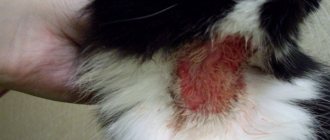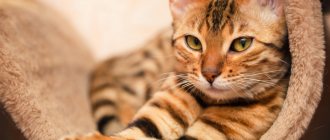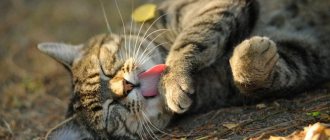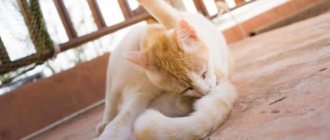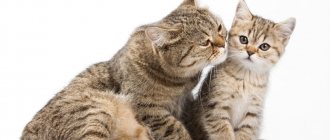Fluffy long-haired cats are very attractive. They are beautiful, graceful, elegant, have an independent and affectionate disposition. But when you get a long-haired cat, keep in mind that you will also get its problems. It's up to you to take care of the luxurious fur coat of this fluffy beauty. Taking care of your cat's fur includes regular brushing, infrequent washing, and removing any tangles that have formed.
What are mats?
The fur of cats, especially long-haired breeds, requires careful care. With a lack of hygiene, poor nutrition and other mistakes when keeping pets, their fur begins to deteriorate. This affects not only appearance, but also health.
Older pets cannot provide themselves with the same careful care as younger pets. The wool begins to get tangled, matted, and tangles form. However, young age is not a guarantee that lumps will not appear.
Why do tangles form?
- Long-haired cats definitely need timely care. If you do not monitor the condition of the animal's fur, very soon the pet will become covered with tangles. Most often they appear in places of bends and friction - behind the ears, armpits, on the stomach, in the groin, and in advanced cases - on the sides.
- Sometimes mats can appear due to improper care of the animal. When washing, you need to gently stroke the fur, and not lather or ruffle it. The fact is that such wool is very difficult to comb, so washing should be delicate.
- During periods when the cat sheds its old fur, the animal must be combed daily. If you don't do this, you won't be able to avoid tangles.
- Sometimes hair may fall out excessively due to poor nutrition. Long-haired cats require a balanced diet, with a full range of vitamins and minerals. If your cat eats dry food, do not forget to supplement its diet with special vitamin complexes.
- If mats appear suddenly, despite careful care of the animal, the condition and hair loss may indicate an illness in the cat. At the same time, the coat often becomes greasy and dull.
In addition to the fact that tangles look terribly unaesthetic, they are also dangerous for the animal. Firstly, in the hot season, mats disrupt normal thermoregulation - the cat can simply overheat, and as a result, traces of dermatitis appear on the skin. The second reason why you need to get rid of tangles as soon as possible is that they are a breeding ground for bacteria. Not only microbes and viruses can settle inside these hairballs, but also larger representatives of insects - fleas and ticks. In addition, tangles really bother the cat herself, bringing her a lot of inconvenience. Often, animals try to get rid of hairballs on their own by tearing them out, leaving injuries on the skin.
All this suggests that tangles should not be allowed to appear on the animal’s fur. If this does happen, you need to get rid of this unpleasant problem as soon as possible.
how to wash a cat if he is afraid of water
Causes
If pets are healthy and can take care of their hygiene, they usually do not develop tangles. However, there are cat breeds with fluffy fur and thick undercoat that are prone to ball formation. These include Persians, British, Turkish Angora and others.
Not all long-haired breeds suffer from mats. For example, Siberian cats and Maine Coons rarely develop lumps. Mainly in places of thick and wavy undercoat (on the “collar”, “pants”).
Mats on wool appear for the following reasons:
- the pet is rarely or not brushed at all;
- during the molting period, the animal’s old fur is not combed out;
- the pet is sick;
- the cat is washed with an incorrectly selected shampoo; when soaping, the fur becomes very crumpled, which is why dense clumps are formed;
- the cat is lazy and fat, obese;
- the pet does not eat rationally, which is why it may develop vitamin deficiency (the fur becomes very loose and the risk of lumps forming increases);
- sticky substances (for example, jam, honey, paint, etc.) have come into contact with the fur;
- pathological conditions develop: oncology, parasites, dermatitis, endocrine disorders.
If a pet develops tangles, the owner is to blame. This means he did not take good care of the animal.
Preventing problems with your cat's coat
Preventive measures for any fluffy long-haired cats, in particular Maine Coons, Siberians, Angoras and Persians, include the following simple rules:
- Brush the animal at least once a week (Persians are scratched more often, sometimes every day).
- To untangle the hair knot, use a special spray.
- When combing your cat's coat, use a comb with round toothed ends so as not to injure the cat.
- When shedding, be sure to remove loose hair using a slicker. At other times, this tool should not be used.
- In extreme heat at the dacha or at home, a very “shaggy” cat should be trimmed. This will not only prevent tangles, but also protect it from overheating and heat stroke.
- Sometimes, to stop the formation of mats, you need to change the cat's food or add a little more fats and vitamins.
A good owner monitors the health of his pet and its appearance. Small fur seals need to be eliminated immediately, then there will be no need for labor-intensive removal of tangles. Simple brushing takes no more than five minutes a day, brings a lot of pleasure to the animal when done correctly and protects it from painful formations in its luxurious fluffy fur.
Why are they dangerous?
The appearance of matted fur spoils the appearance of the animal. This is a huge disadvantage for a breeder of purebred cats. In addition, petting a pet with mats is unpleasant.
However, these are not the worst consequences. Mats can provoke the development of various diseases. Pathogenic microorganisms begin to multiply in matted wool. When a pet licks itself, they enter the body and continue their synthesis there.
Fleas, lice, ticks and other parasites take root well in tangles. The skin under the lumps becomes rotten, dermatological problems arise that are difficult to treat. In addition, the cat will try to independently remove matted fur with its claws, and in the process may cause wounds to itself. Such damage will take a long time to heal.
The harm of downed wool to animal health
When mats occur in cats, its natural ability to lick itself is disrupted, the coat becomes dirty and greasy, and this is an excellent breeding ground for microorganisms. Such an animal is at greater risk than others of contracting fungus, lichen, as well as fleas and lice.
Under the rough clumps that matted and compacted fur forms, diaper rash and irritation of the skin appear, and it can become inflamed. In addition, the animal experiences discomfort and pain, as the lumps pull on the skin. If there are a lot of them, the animal suffers greatly and can get sick, and its character even deteriorates.
Removal methods
Tangles are removed from wool in the following ways:
- If the lumps are small, you can comb them out. The pet should be placed on its side and stroked. This is necessary so that he calms down and does not break out. First, comb the sides and back, neck and chest, forelimbs, tail. It is more difficult to get rid of tangles on the stomach and hind legs. Most likely the animal will bite.
- Large clumps are recommended to be cut lengthwise and then combed.
- If there are a lot of tangles, it is completely impossible to comb them out, then the tangled hair will have to be cut to the ground. You need to be very careful: a cat’s skin is thin and can be easily damaged. Clumps can be removed with scissors, people clippers or hair clippers. The receding hairline will heal after a few months.
- At the pet store you can purchase a special device called a tangle cutter. This is a comb with blunt ends, blades between the teeth.
- You can take your cat to a veterinarian or pet groomer. There your pet will be trimmed at an affordable cost.
- To deal with long unnecessary hair, there is a special comb - a furminator. Not only will it help get rid of clumps, but it will also be an indispensable tool for daily combing.
How to cut out a hairball correctly
When the need to cut off lumps arises, the question arises; how to remove small tangles from a domestic cat without accidentally injuring it. Firstly, the animal must be fixed, secondly, use sharp scissors with blunt edges, and thirdly, cut along the formation, and then carefully, step by step, cut it from the fur.
Sometimes it is recommended to use an anti-matt spray for cats, reviews of which are very favorable and positive. It is especially necessary for animals with “cotton” hair, like Persians and Angoras. With its help, you can quickly and painlessly remove tangles.
Rules for removing mats in cats
Recommendations for removing mats:
- The process of eliminating lumps is long. Most likely, your pet will not like it. The pet will not give in and will start fighting. Therefore, it is better to comb out tangles together: one person holds the cat, the other combs it. If the animal is very nervous, then it is better not to traumatize its psyche and get rid of the matted fur not at once, but several times.
- Only areas with long hair are clipped. It is better not to touch the paws and head. It's okay if your pet looks like a lion. The fur will grow back in a couple of months.
- Until the mats are removed, washing the animal is prohibited. After water, lumps are more difficult to comb out.
- After combing, treat the pet's fur with an antistatic spray. The product will detangle your hair and prevent further formation of tangles.
Grooming the cat
During the period of active molting or after an illness, mats in a fluffy cat can cover almost its entire body. This often happens in cats that have free range or are taken to the countryside for the summer. You can’t leave the fur like that, as dust, dirt, insects and plant particles will get into the formations, causing the animal to suffer greatly.
In the heat, under such felt knots, the skin will swell and become inflamed. Therefore, if a cat’s fur is all matted, and the cat mat remover does not work, the only thing left to do is to completely cut off the matted area of fur.
Sometimes, when almost the entire fur coat has fallen off, after removing the mats, the animal is clipper-haired, leaving only the head, tail, and sometimes the “collar” fluffy. Then the fur will grow evenly, it will be easy to care for, and the animal will quickly regain its aesthetic appearance.
If your animal is aggressive or you don't know how to cut it, contact your veterinarian or pet grooming salon for help. There, the injured cat will quickly be restored to perfect condition.
Preventive measures
The formation of lumps is easier to prevent than to deal with them later. You need to set aside time every day to care for your pet. It is recommended to brush the animal regularly.
Your pet should be accustomed to brushing when he is still a small kitten. The pet will get used to it and in adulthood there will be no problems with combing.
You cannot use a regular “human” comb on a cat. A personal toiletry item is selected for the pet based on the type and length of fur.
For young animals and kittens, it is recommended to purchase a brush. It is better to buy with artificial bristles that have an antistatic effect.
After washing, until the pet is dry, a massage mitten takes good care of the fur. But it is not able to completely replace a comb.
A cat comb is perfect for daily brushing. It has rounded ends and will not cause pain to your pet. Available in any length and width. When combing with a comb, you can find fleas if they are infested.
For very fluffy pets, a slicker is used (for example, for the British breed). It looks like a brush, but instead of bristles it has small metal teeth with curved ends. It is only suitable for preventing mats in cats with healthy fur.
A furminator (comb-trimmer) is used to comb out the undercoat. Such a gadget costs a lot, but it helps save time on caring for your pet. The device comes in various types: for kittens, long-haired, short-haired breeds.
The pet must be taken to the veterinary clinic periodically for examination. This will help not only to promptly detect the formation of lumps, but also to prevent various pathological conditions. Also, a cat with long hair (for example, a Persian) needs to be cut before the summer season.
Prevention of tangles
The appearance of tangles can be prevented. To do this you need:
- comb the cat once a day or at least once every 2 days for 10 minutes, and this should be done with different types of combs: for the undercoat;
- for fluff;
- for guard hairs;
- Additionally, stock up on massage combs that stimulate blood microcirculation in the skin capillaries, which provides nutrition to the hair roots;
- the furminator is another good combing device that allows you to easily remove dead hair and fluff;
Using a furminator, you can quickly remove dead hair and fluff from a cat's coat.
Pets can be cut for the summer
You need to care for your cat's long hair like this:
- When bathing, it is better to use special cat shampoos that make the animal’s fur silky and not prone to tangles, for example, the following: Perfect Coat 8 in 1;
- shampoo-conditioner for long-haired cats “Luxury Lioness”;
- Herba Vitae for long-haired cats;
- Biovax shampoo for long-haired cats;
After washing the cat, you need to dry and comb it
Photo gallery: shampoos for long-haired cats
Perfect Coat reduces hair loss Shampoo-conditioner “Luxurious Lioness” restores hair structure and strengthens its roots Natural extracts of heather and hawthorn in Biovax shampoo have wound-healing and tonic effects Herba Vitae contains extracts of knotweed and horsetail and has a beneficial effect on the skin and coat
Video: how to properly comb a cat
Fighting methods
First of all, you need to have a comb, a special shampoo and conditioner for long-haired animals in the house. Conditioner makes the coat silky and less prone to tangling. This kind of fur is easier to comb out.
Small tangles are carefully selected with your fingers, and the animal is stroked and calmed during this procedure. If the tangle is noticed late and has acquired critical dimensions, a haircut is indispensable. There is no need to be afraid - cats usually tolerate such procedures well.
It is recommended to cut small areas yourself using scissors or special wedge cutters. Only a clipper can handle large lesions that interfere with the cat’s movement.
Many pet salons offer cat haircuts. Owners of Persian cats often use these services. The animal's fur is constantly renewed, and no tangles are dangerous.
